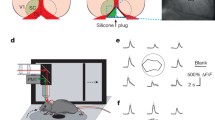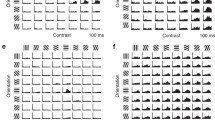Summary
The responses of 82 simple cells and 41 complex cells in area 17 of anesthetized and paralysed cats were examined with light bars of different length. For 84% of the simple cells and 66% of the complex cells the preferred axis of orientation of a stationary flashing long bar (orientational selectivity) and the preferred axis of movement of a small spot were parallel. As a consequence, the axis of maximal response to a moving light spot was mostly orthogonal to the optimal axis of a moving bar. Thus, a single cell responds to two perpendicular axes of preferred movement one for a long bar and one for a light spot, respectively. For both axes independent direction preferences could be distinguished. Additional preferred axes of movement between the two orthogonal extremes could be found with moving bars of intermediate lengths. This can be explained by the fact that cells with a pronounced response to a moving spot showed a strong tendency for intermediate bar length to elicit responses consisting of a superposition of both components. Therefore, decreasing bar length resulted in a gradual rotation of the preferred direction of movement from orthogonal to parallel with respect to the orientational axis, rather than to a mere widening of the tuning curve. Accordingly, the change in orientation selectivity with decreasing bar length is a regular transition from the orientation dependent response to a response type that depends only on the movement axis of the spot. Thus, in a simple model, the resulting response characteristic can be interpreted as an average of both components weighted according to the length of the stimulus.
Similar content being viewed by others
References
Bishop PO, Coombs JS, Henry GH (1971) Responses to visual contours: spatio temporal aspects of excitation in the receptive fields of simple striate neurones. J Physiol (Lond) 219:625–657
Dean AF, Tolhurst DJ (1983) On the distinctness of simple and complex cells in the visual cortex of the cat. J Physiol (Lond) 344:305–325
Eysel UT, Wörgötter F, Pape HC (1987) Local cortical lesions abolish lateral inhibition at direction selective cells in cat visual cortex. Exp Brain Res 68:606–612
Eysel UT, Muche T, Wörgötter F (1988) Lateral interactions at direction-selective striate neurones in the cat demonstrated by local cortical inactivation. J Physiol (Lond) 399:657–675
Heggelund P, Albus K (1978) Orientation selectivity of single cells in striate cortex of cat: the shape of orientation tuning curves. Vision Res 18:1067–1071
Henry GH (1977) Receptive field classes of cells in the striate cortex of the cat. Brain Res 133:1–28
Henry GH, Bishop PO, Dreher B (1974a) Orientation, axis and direction as stimulus parameters for striate cells. Vision Res 14:767–777
Henry GH, Dreher B, Bishop PO (1974b) Orientation specificity of cells in cat striate cortex. J Neurophysiol 37:1394–1409
Henry GH, Bishop PO, Tupper RM and Dreher B (1973) Orientation specificity and response variability of cells in the striate cortex. Vision Res 13:1771–1779
Hubel DH, Wiesel TN (1962) Receptive fields, binocular interaction and functional architecture in the cat's visual cortex. J Physiol (Lond) 160:106–154
Orban GA (1984) Neuronal operations in the visual cortex. Springer, Berlin
Orban GA, Kato H, Bishop PO (1979) End-zone region in receptive fields of hypercomplex and other striate neurons in the cat. J Neurophysiol 42:818–832
Rose D (1977) Responses of single units in cat visual cortex to moving bars of light as a function of bar length. J Physiol (Lond) 271:1–23
Rose D, Blakemore C (1974) An analysis of orientation selectivity in the cat's visual cortex. Exp Brain Res 20:1–17
Wörgötter F, Eysel UT (1988) A simple glass-coated, fire-polished tungsten electrode with conductance adjustment using hydrofluoric acid. J Neurosci Meth 25:135–138
Author information
Authors and Affiliations
Rights and permissions
About this article
Cite this article
Wörgötter, F., Eysel, U.T. Axis of preferred motion is a function of bar length in visual cortical receptive fields. Exp Brain Res 76, 307–314 (1989). https://doi.org/10.1007/BF00247890
Received:
Accepted:
Issue Date:
DOI: https://doi.org/10.1007/BF00247890




